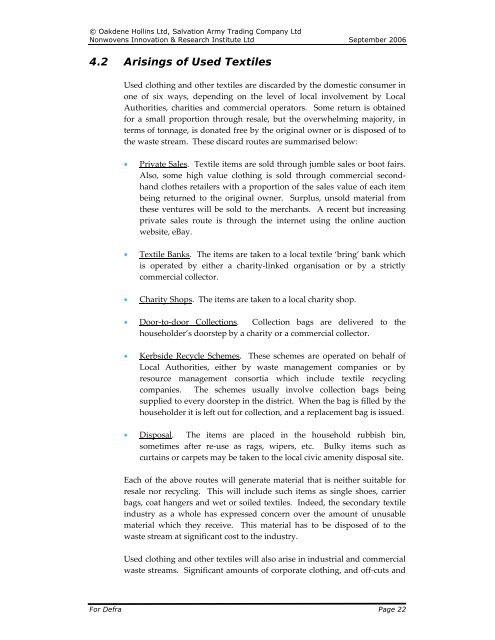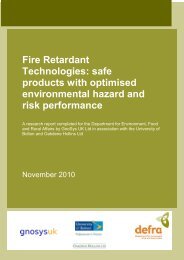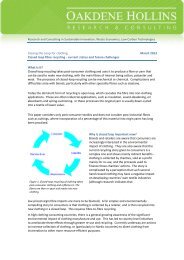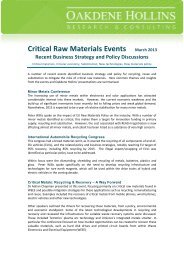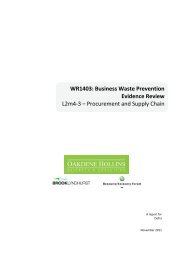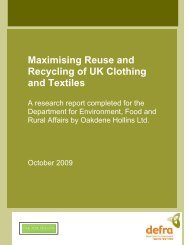Recycling of Low Grade Clothing Waste - Oakdene Hollins
Recycling of Low Grade Clothing Waste - Oakdene Hollins
Recycling of Low Grade Clothing Waste - Oakdene Hollins
You also want an ePaper? Increase the reach of your titles
YUMPU automatically turns print PDFs into web optimized ePapers that Google loves.
© <strong>Oakdene</strong> <strong>Hollins</strong> Ltd, Salvation Army Trading Company Ltd<br />
Nonwovens Innovation & Research Institute Ltd September 2006<br />
4.2 Arisings <strong>of</strong> Used Textiles<br />
Used clothing and other textiles are discarded by the domestic consumer in<br />
one <strong>of</strong> six ways, depending on the level <strong>of</strong> local involvement by Local<br />
Authorities, charities and commercial operators. Some return is obtained<br />
for a small proportion through resale, but the overwhelming majority, in<br />
terms <strong>of</strong> tonnage, is donated free by the original owner or is disposed <strong>of</strong> to<br />
the waste stream. These discard routes are summarised below:<br />
• Private Sales. Textile items are sold through jumble sales or boot fairs.<br />
Also, some high value clothing is sold through commercial secondhand<br />
clothes retailers with a proportion <strong>of</strong> the sales value <strong>of</strong> each item<br />
being returned to the original owner. Surplus, unsold material from<br />
these ventures will be sold to the merchants. A recent but increasing<br />
private sales route is through the internet using the online auction<br />
website, eBay.<br />
• Textile Banks. The items are taken to a local textile ‘bring’ bank which<br />
is operated by either a charity‐linked organisation or by a strictly<br />
commercial collector.<br />
• Charity Shops. The items are taken to a local charity shop.<br />
• Door‐to‐door Collections. Collection bags are delivered to the<br />
householder’s doorstep by a charity or a commercial collector.<br />
• Kerbside Recycle Schemes. These schemes are operated on behalf <strong>of</strong><br />
Local Authorities, either by waste management companies or by<br />
resource management consortia which include textile recycling<br />
companies. The schemes usually involve collection bags being<br />
supplied to every doorstep in the district. When the bag is filled by the<br />
householder it is left out for collection, and a replacement bag is issued.<br />
• Disposal. The items are placed in the household rubbish bin,<br />
sometimes after re‐use as rags, wipers, etc. Bulky items such as<br />
curtains or carpets may be taken to the local civic amenity disposal site.<br />
Each <strong>of</strong> the above routes will generate material that is neither suitable for<br />
resale nor recycling. This will include such items as single shoes, carrier<br />
bags, coat hangers and wet or soiled textiles. Indeed, the secondary textile<br />
industry as a whole has expressed concern over the amount <strong>of</strong> unusable<br />
material which they receive. This material has to be disposed <strong>of</strong> to the<br />
waste stream at significant cost to the industry.<br />
Used clothing and other textiles will also arise in industrial and commercial<br />
waste streams. Significant amounts <strong>of</strong> corporate clothing, and <strong>of</strong>f‐cuts and<br />
For Defra Page 22


